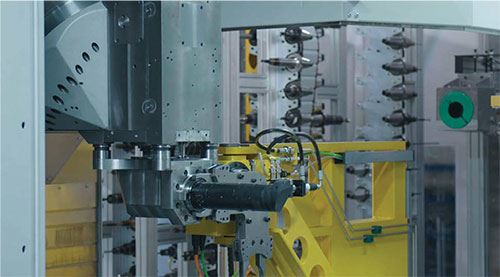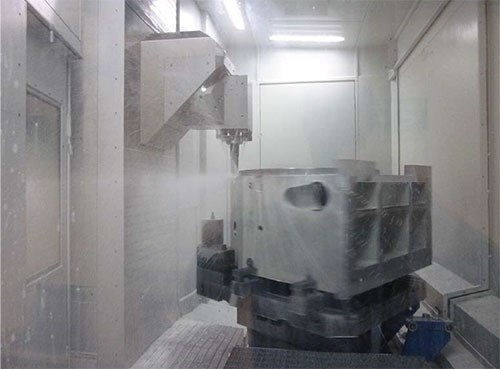Technology for Turning on a Five-Axis Machine
A turning tool adapter that mounts to the MCT five-axis machine isolates the main spindle bearing from the shock of turning operations.
Five-axis machine tools combine linear XYZ travels with A- and B-axis rotation to enable the machining of five sides of a part in one setup. Some are used to perform 3+2 operations, whereby the part is rotated and locked into an angled position, and the machine essentially performs a three-axis operation with the part oriented in that way. Others can execute more complex, full-contouring five-axis operations that use simultaneous linear and rotational motions to pass a cutting tool over a contoured surface.
In some cases, attachments can be used to enable these machines to perform turning operations, too. However, when static turning tools are mounted directly into a machine’s main spindle, as they typically are, the shock loads common to turning can eventually lead to spindle bearing damage.
This has spurred Burkhardt + Weber, part of Industrias Romi SA, to develop its MCT line of five-axis machines. The MCT series includes five machine models that can turn parts ranging in diameter from 11.8 to 110 inches and weighing as much as 8,818 pounds at a maximum rotational speed of 600 rpm (workpiece capacity when turning is not performed is 15,432 pounds). These machines feature the following integral design elements said to enable productive turning, even for non-symmetrical parts, without causing damage to the spindle bearing system:
Turning tool adapter. With the conventional approach of inserting a static turning tool into a five-axis machine’s spindle, the spindle rotor is often clamped to the spindle’s outer housing in order to lock it in a stationary position to protect against possible turning shock loads. Lighter cuts are also typically performed to prevent bearing damage, but this leads to lower productivity.
Conversely, the MCT machines feature an automatically exchanged tooling adapter that mounts to the spindle housing via a zero-point clamping mechanism, isolating the spindle bearings from the shock of turning operations. The system uses four clamping cylinders located 9.84 inches apart and supplies 26,400 pounds of clamping force to secure the turning tool adapter to the spindle housing. Turning tools can be automatically loaded and unloaded into the adapter just like a milling tool from the machine’s ATC.
Table balance control. Because parts to be turned on a five-axis machine often aren’t symmetric, the MCT machines feature a compensating balance-control system. After a part or pallet is loaded and securely clamped to the machine’s table via a mechanical spring-based safety system, a balancing cycle is automatically performed at 80 rpm using sensors to measure rotational forces. Afterwards, a display on the machine’s CNC shows the location and amount of counterweight required to bring the system into balance. Turning operations can proceed once balance quality is confirmed after another 80-rpm test cycle.
Thermal isolation system. Torque motors in rotary tables used for turning on a five-axis machine generate a good deal of heat, causing unpredictable expansion and contraction of a machine’s frame that can adversely affect accuracy and repeatability. Rather than using complex temperature-compensating software algorithms and sensor feedback, the MCT machines remove heat surrounding the table and frame with an actively controlled cooling system, stabilizing the frame by maintaining a consistent temperature. In addition, the company developed a non-contact, 16-channel hydraulic rotary sealing system for the machine line’s 600-rpm tables that does not generate heat due to friction or wear of mating seal surfaces common to
conventional systems.
Related Content
Understanding Swiss-Type Machining
Once seen as a specialty machine tool, the CNC Swiss-type is increasingly being used in shops that are full of more conventional CNC machines. For the newcomer to Swiss-type machining, here is what the learning curve is like.
Read MoreThreading On A Lathe
The right choices in tooling and technique can optimize the thread turning process.
Read MoreWatchmaking: A Machinist’s View
Old-world craftsmanship combines with precision machining on a vertical machining center and Swiss-type lathe to produce some of the only U.S.-made mechanical wristwatch movements.
Read MoreBuying a Lathe: The Basics
Lathes represent some of the oldest machining technology, but it’s still helpful to remember the basics when considering the purchase of a new turning machine.
Read MoreRead Next
3 Mistakes That Cause CNC Programs to Fail
Despite enhancements to manufacturing technology, there are still issues today that can cause programs to fail. These failures can cause lost time, scrapped parts, damaged machines and even injured operators.
Read MoreThe Cut Scene: The Finer Details of Large-Format Machining
Small details and features can have an outsized impact on large parts, such as Barbco’s collapsible utility drill head.
Read More.jpg;maxWidth=970;quality=90)
.jpg;width=70;height=70;mode=crop)








.jpg;maxWidth=300;quality=90)



.png;maxWidth=300;quality=90)






.png;maxWidth=300;quality=90)







